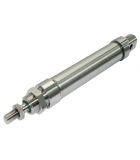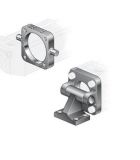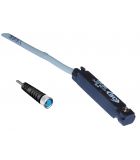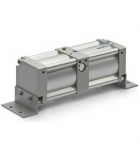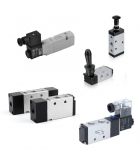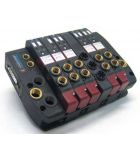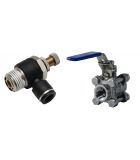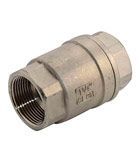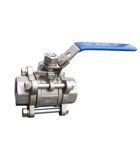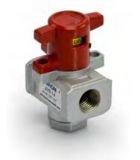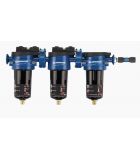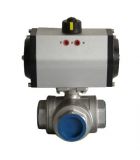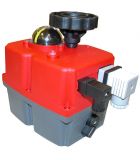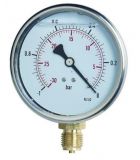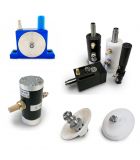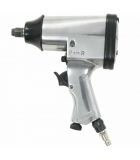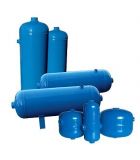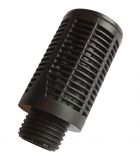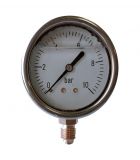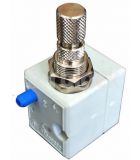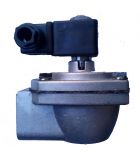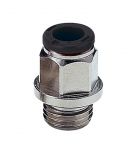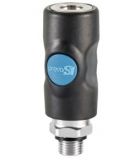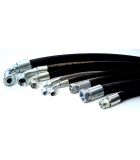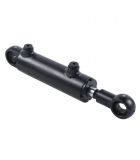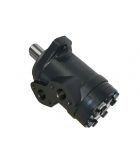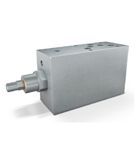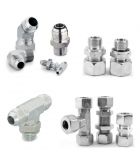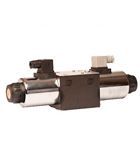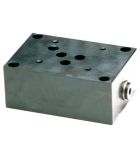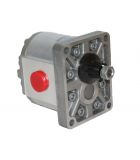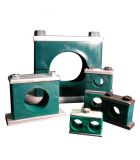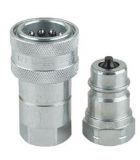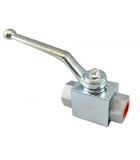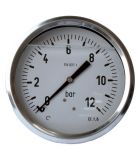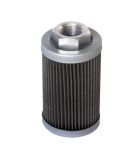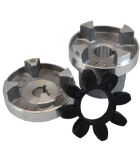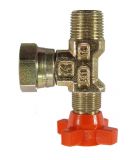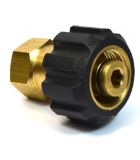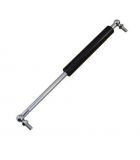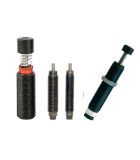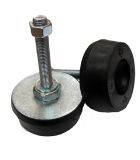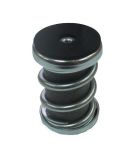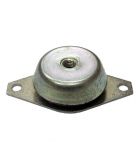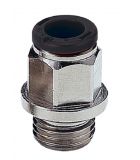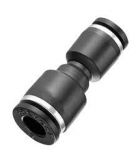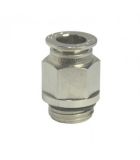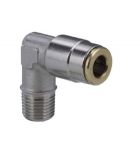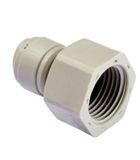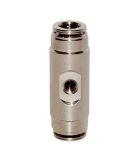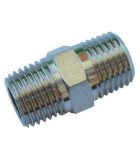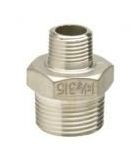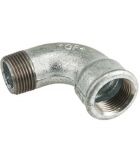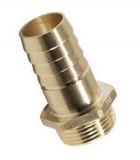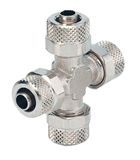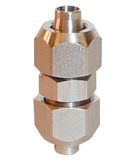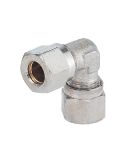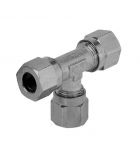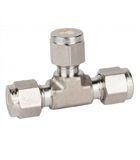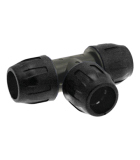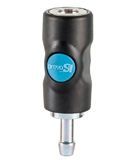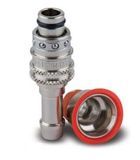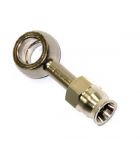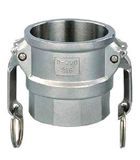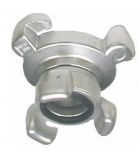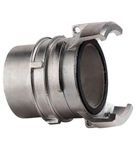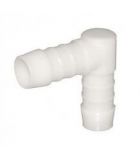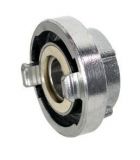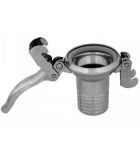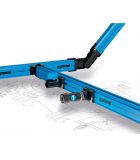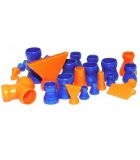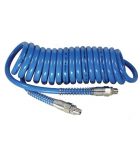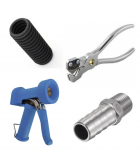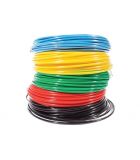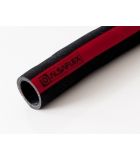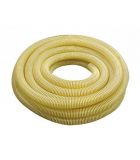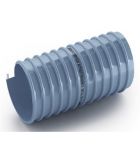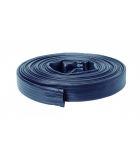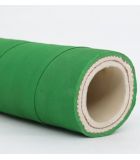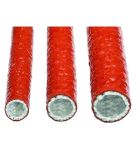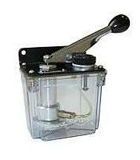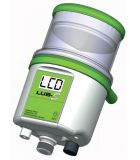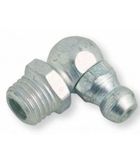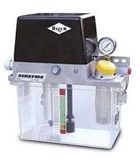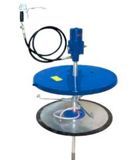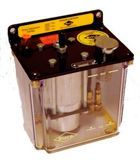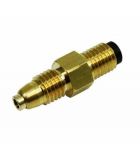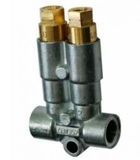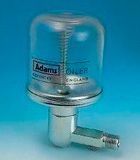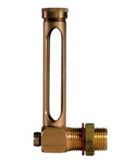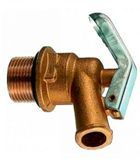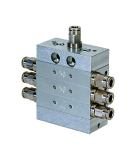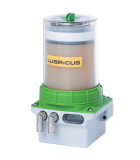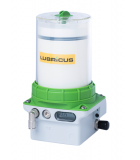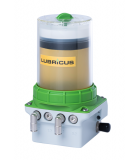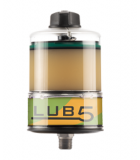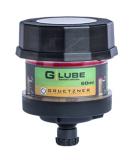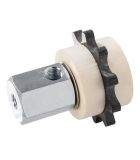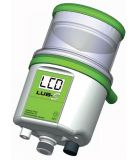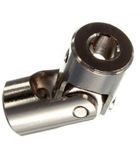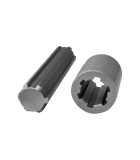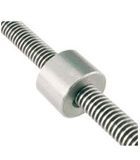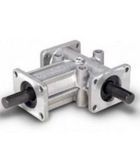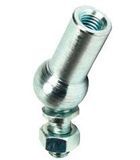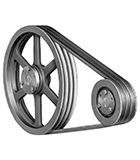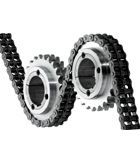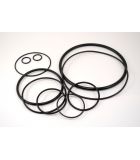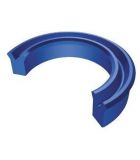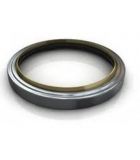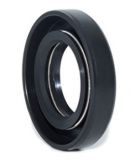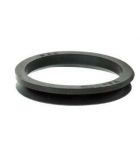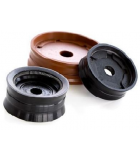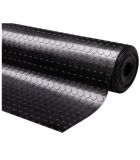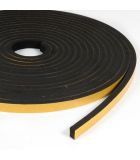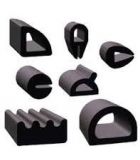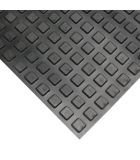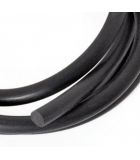STAINLESS
Subcategories
-
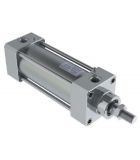
STAINLESS STEEL PNEUMATIC CYLINDERS
<h2>Stainless Pneumatic Cylinders. Buy single-acting or double-acting cylinders.</h2> <p>Stainless pneumatic cylinders are mechanical elements that transform the energy of compressed air into kinetic (motion), linear or rotary energy. These cylinders perform movements, linear, rotary and angular movements, feeding and lifting. They have the power to make instantaneous changes of direction.</p> <h3>Function of stainless pneumatic cylinders</h3> <p>The function of stainless pneumatic cylinders can be single or double acting. Their diameters range from 6 to 320 mm and they can exert a force of 3 to 55,000 Nw. The speed ranges from 25 mm/sg to 1 mt/sg.</p> <h3>Types of stainless pneumatic cylinders</h3> <p>The types of pneumatic cylinders can be the standard type that meets the ISO-6431 ISO-6432, ISO-21287, ISO-15552 VDMA standards and metering cylinders.</p> <h3>Parts of stainless pneumatic cylinders</h3> <p>The main parts of a stainless pneumatic cylinder are:</p> <ul style="list-style-type:disc;"><li>The stem</li> <li>The cylinder heads</li> <li>The Piston</li> <li>The boards.</li> </ul><p>Except for the gaskets, all other components of the pneumatic cylinder are made of stainless steel.</p> <p>They are simple elements and easy to assemble. It requires little maintenance and is economical to install. Long durability, changing the gasket kit. Pneumatic cylinders can be manufactured from a wide variety of materials and can be used in extreme conditions.</p> <p>Stainless pneumatic cylinders are safe, do not have explosive characteristics or produce excessive heat. The compressed air used to move the pneumatic cylinders does not generate water hammer, which reduces breakdowns or damage to the equipment.</p> <p>They are used in all types of industries that are related to the food-health sector, chemicals, pharmaceuticals and in all types of industries, where automation is present.</p> -
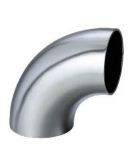
STAINLESS STEEL FITTINGS
<h2>Stainless Steel Fittings. Buy online at the best price</h2><p> Stainless steel fittings are pieces made of stainless steel, which are used to join tubes and fittings together. When they do not vary in size, they can also be known as "nipples". Stainless steel fittings have endless applications in numerous and widely used fields.</p><p> They can be manufactured in different qualities, I-303, I-304, I-316, etc. They withstand a lot of temperature and depending on the type of fitting, they can withstand a lot of pressure.</p><h3> Types of stainless steel fittings:</h3><p> <strong>Stainless Microcast Fitting:</strong> A microcast fitting is a type of pipe or threaded fitting used to connect two or more threaded pipes or pipe components. This accessory is microcast, which means it is manufactured using a casting process in which the material is melted and poured into a mold, where it cools and solidifies. Microfusion fittings are used in a variety of applications, including industry and construction. They are strong, durable and have a smooth finish, making them ideal for a wide variety of plumbing systems. In addition, its design allows for a safe and airtight connection between pipes, which helps prevent fluid or gas leaks.</p><p> <strong>Stainless quick plug fitting.</strong> A stainless steel quick coupler fitting is a type of pipe fitting that allows you to connect and disconnect pipes and components quickly and easily, without the need for additional tools. This type of fitting usually has a locking and unlocking mechanism that allows connection and disconnection to be carried out with a simple manual movement. They are ideal for systems that require frequent connection and disconnection. Quick-plug fittings are used in a wide variety of applications , industry, construction and agriculture.</p><p> They are ideal for systems that require frequent connection and disconnection, allowing easy access for maintenance or changes to the piping system. Additionally, its design allows for a secure and airtight connection, which helps prevent fluid or gas leaks. They withstand temperatures up to 150ºC and withstand pressures of 15 bar</p><p> <strong>Stainless Semi-Quick Plug Fitting:</strong> A stainless steel semi-quick plug fitting is a type of pipe fitting that allows pipes and components to be quickly connected and disconnected by threading and tightening with the fitting and pipe. This type of fitting is usually used in liquids and fluids, allowing connection and disconnection to be made with a simple wrench movement. Semi-quick plug fittings are used in a wide variety of applications, industry, construction and agriculture. Additionally, its design allows for a secure and airtight connection, which helps prevent fluid or gas leaks. They withstand a pressure of 20 bar and withstand temperatures up to 230ºC</p><p> <strong>Stainless Bicone and Nut Fitting:</strong> It is a type of pipe fitting used to connect two threaded pipes or pipe components. This type of fitting consists of two pieces: a nut and a bicone.<br/> The nut is placed on the end of one pipe, while the bicone is placed on the end of another pipe. The two pieces are connected and adjusted to each other using threads and a locking nut, it remains fixed and seals when tightened. Once the bicone is tightened it cannot be reused.<br/> Nut and bicone fittings are used in a wide variety of applications, including industry, construction and agriculture. They are strong and durable, and their design allows for a secure, airtight connection between pipes, helping to prevent fluid or gas leaks. Additionally, its construction allows for a precise and adjustable fit, which is useful for piping systems that require an adjustable connection. They can withstand a pressure of 100 bar and a temperature of 230ºC</p><p> <strong>Stainless Steel Instrumentation Fitting:</strong> A stainless instrumentation fitting is a type of pipe fitting used in fluid processing systems and in the processing industry, where high pressures and high temperatures exist. This type of fitting is used to connect piping components, such as sensors, valves, and other measurement and control equipment.</p><p> Instrumentation fittings are manufactured from high quality stainless steel and have a smooth finish to minimize pressure losses and fluid leaks. Additionally, its design allows for a secure, airtight connection between pipeline components, which is essential to ensure accurate measurement and reliable control in processing systems.</p><p> The closing system is a nut and double bicone. Some instrumentation fittings can be male and female type, while others can be thread and tube type or plug type. All of them are used to connect piping components safely and reliably, and are a key component in many industrial and fluid processing systems. They can withstand a pressure of 420 bar and temperatures of 425ºC</p><p> <strong>Stainless Press Fitting:</strong> A stainless steel press fitting is a type of accessory that is used to connect fittings to pipes safely and hermetically without the need for welding or additional tools. This type of fitting works through the use of a mechanical, manual or electric press, and is used to apply pressure to the ends of the pipes, sealing them together and creating a strong and durable connection, in which an O-ring is housed inside.</p><p> Stainless press fittings are used in a wide variety of applications, including industry, construction and agriculture. They are ideal for high-pressure piping systems as their design allows for a secure, airtight connection without the need for welding. In addition, they are easy to install and allow a quick and easy connection, which is useful in situations where a quick and eficiente.Soportan installation is required. They withstand up to 16 bar of pressure and can work at a temperature of 120ºC</p><p> <strong>Stainless DIN-2353 fittings:</strong> The DIN 2353 Stainless fitting is a type of pipe fitting that is used in industrial and fluid processing applications, normally hydraulic oil. This type of fitting is a connecting component used to connect pipe components securely and airtight. The DIN 2353 fitting is made of stainless steel with high quality materials and is designed to meet DIN 2353 standards, which are German technical standards that establish the requirements and specifications for pipe fittings.</p><p> These standards include requirements for the dimension, shape and finish of the fitting components, as well as their mechanical and pressure resistance. The closing system is produced by means of a nut and bicone. DIN 2353 stainless steel fittings are used in a wide variety of applications, including the fluid processing industry, construction of piping systems, automotive and agriculture. Its design allows for a secure and tight connection between piping components, which is essential to ensure accurate measurement and reliable control in processing systems.</p><p> They withstand a pressure of more than 600 bar, depending on the model and diameter, and a temperature of 400ºC.</p><p> <strong>Stainless Weld Fittings:</strong> Stainless weld fittings are pipe components used to securely and airtightly connect pipes by welding. These fittings are used in high pressure and temperature applications, and are available in a wide variety of sizes and materials to suit specific application needs. There is an exclusive range for the food and pharmaceutical industry, they have a polishing process, both inside and outside, with a shiny finish. Welding accessories include elbows, tees, flanges, reducers, etc.</p><p> All of these components are designed to meet specific welding standards and to provide a secure and durable connection for the pipe. Importantly, correct soldering is essential to ensure a secure and long-lasting connection with soldering accessories. Therefore, it is advisable to work with a qualified welder and follow the manufacturer's instructions to ensure proper welding.</p> -
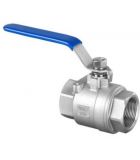
STAINLESS STEEL VALVES
<h2>Stainless steel valve. Buy pneumatic valves.</h2><p> <strong>Stainless valves</strong> are elements that are operated manually, usually with a lever or a knob. Its function is to direct or cut off the passage of compressed air or any fluid.</p><p> <strong>Stainless distributors</strong> are the mechanical devices that direct, manipulate and regulate the movement of compressed air; the closing or enabling, the direction and the flow of compressed air, in all its devices or peripherals.</p><h3> Types of pneumatic auxiliary valves</h3><p> The types of pneumatic auxiliary valves could be selected from:</p><p> 1.- <strong>Stainless flow regulating valves</strong> Using a knob, this type of valve regulates the speed of a cylinder or peripheral associated with it.</p><p> 2.- <strong>Stainless non-return or check valves</strong> . These valves leave the passage of compressed air free in one direction and prevent passage in the opposite direction.</p><p> 3.- <strong>Stainless safety valves.</strong> The stainless safety valve is a safety device used to evacuate the necessary fluid flow from a pressure vessel, installation or equipment, in such a way that it does not constantly exceed the maximum admissible pressure. This valve defines the maximum pressure, preventing it from exceeding it; a spring opens to let excess pressure escape.</p><h3> Types of stainless manual valves</h3><p> The types of stainless valves could be selected from:</p><p> 1.- <strong>Ball or sphere valves</strong> are a stopcock mechanism that serves to regulate the flow of a channeled fluid and is characterized by the fact that the regulatory mechanism located inside is in the shape of a perforated sphere. The sealing is done using a Teflon gasket.</p><p> 2.- <strong>Butterfly valves,</strong> A butterfly valve is a device to interrupt or regulate the flow of a fluid in a pipe by increasing or reducing the passage section by means of a plate or disc, called a "butterfly", that rotates on an axis. By decreasing the passage area, the local pressure loss in the valve increases, reducing the flow. The closure is varied depending on the fluid that circulates. It can be EPDM, NBR, PTFE. The stainless steel disc</p><p> They are simple elements and easy to assemble. It requires little maintenance and is economical to install. Long durability.</p><p> Pneumatic manual valves are safe, do not have explosive characteristics or produce excessive heat. They are used in all types of industries and sectors, given their wide range of uses.</p><p> Pneumatic distributors are safe, do not have explosive characteristics or produce excessive heat. The compressed air used to move the pneumatic cylinders does not generate water hammer, which reduces breakdowns or damage to the equipment. They are used in practically all types of industries, where automation is present.</p> -
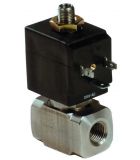
STAINLESS STEEL SOLENOID VALVES
<h2>Stainless steel solenoid valve. Buy online at the best price</h2><p> Stainless solenoid valves are electric valves used in a wide variety of industrial and fluid processing applications. These valves are made of stainless steel, with various types of qualities, which makes them resistant to corrosion and oxidation, making them suitable for applications in aggressive environments.</p><p> Stainless solenoid valves operate by applying an electrical signal, which controls the position of the valve. This allows it to be opened or closed to control the flow of liquids or gases in a piping system.</p><p> There are different types of stainless solenoid valves available, including solenoid valves, pilot valves, butterfly valves, etc. All these types of valves are available in different sizes and various types of gasket or membrane materials, and can be adapted to a wide variety of applications and technical requirements.</p><p> It is important to note that stainless solenoid valves must be selected and used properly to ensure safe and efficient operation. Therefore, it is advisable to work with a reliable supplier and follow the manufacturer's instructions to ensure proper installation and use of the valve.</p><p> Depending on the model, it can withstand a lot of pressure and temperature. Stainless solenoid valves have a wide range of applications due to their corrosion and oxidation resistance properties.</p><p> Some of the common applications include:</p><p> <strong>Food and Beverage Processing:</strong> Stainless solenoid valves are used in the food and beverage industry to control the flow of liquids and gases in food and beverage processing applications.</p><p> <strong>Chemical Processing:</strong> Stainless solenoid valves are suitable for chemical processing applications due to their resistance to corrosive chemicals.</p><p> <strong>Petrochemical Industry:</strong> Stainless solenoid valves are used in the petrochemical industry to control the flow of fluids and gases in oil and gas production and processing applications.</p><p> <strong>Marine Installations:</strong> Stainless solenoid valves are used in marine installations to control the flow of fluids and gases in offshore applications.</p><p> <strong>Pharmaceutical Industry:</strong> Stainless solenoid valves are used in the pharmaceutical industry to control the flow of liquids and gases in drug processing applications.</p><p> <strong>Water Treatment Facilities:</strong> Stainless solenoid valves are used in water treatment facilities to control the flow of water in the treatment process.</p><p> <strong>-Energy installations:</strong> Stainless solenoid valves are used in energy installations to control the flow of fluids and gases in energy production and distribution applications.</p><p> These are just a few of the applications for stainless solenoid valves, and there are many more depending on the industry and specific application needs.</p> -
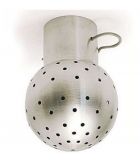
STAINLESS STEEL ACCESSORIES
<h2>STAINLESS STEEL ACCESSORIES. Buy online at the best price</h2><p> Stainless steel fittings are very common in the industry due to their high corrosion resistance, durability and ease of cleaning. Some of the most common accessories for the industry are:</p><p> <strong>Valves:</strong> Stainless steel valves are a type of valve that is used in all types of industries to control the flow of liquids or gases in a system. They are composed of a perforated ball and a valve body that can be manufactured in stainless steel, which makes them corrosion resistant and durable. Stainless ball valves are used in a wide variety of applications in the chemical, pharmaceutical, food and other applications requiring a high level of hygiene.</p><p> Due to their simple and robust design, stainless ball valves are easy to install, operate and maintain, and are capable of withstanding high pressures and temperatures. One of the main advantages of stainless ball valves is that they allow very precise fluid flow and quick, safe closure, which prevents leaks and minimizes the risk of contamination in the system. Additionally, the smooth surface of the stainless steel used in the manufacture of these valves makes them easy to clean and sterilize, which is essential in many applications where a high level of hygiene is required.</p><p> <strong>Stainless steel connections and fittings:</strong> Stainless steel connections and fittings are elements used in all types of industry to join pipes, hoses and other components of fluid systems. They are made of stainless steel, which provides them with high resistance to corrosion and great durability. Stainless connections and fittings are used in a wide variety of applications in the chemical, pharmaceutical, food and other industries that require a high level of hygiene. They can be found in different shapes and sizes, from threaded connections to compression fittings, and are designed to withstand high pressures and temperatures. One of the main advantages of stainless connections and fittings is that they provide a tight and secure seal between fluid system components, minimizing the risk of leaks and contamination.</p><p> Furthermore, the smooth surface of the stainless steel used in the manufacture of these connections and fittings makes them easy to clean and sterilize, which is essential in many applications where a high level of hygiene is required. Stainless steel connections and fittings are a popular and reliable choice for the industry due to their corrosion resistance, durability, ease of cleaning, and safety in sealing fluid systems.</p><p> <strong>CIP cleaning balls:</strong> are devices used in the food, pharmaceutical, chemical and other industries that require sanitary cleaning and sterilization processes. These balls are designed to be connected to cleaning systems and work by injecting water or other high-pressure cleaning fluids through the ball. The high pressure and liquid flow generated by the CIP cleaning ball allows for complete and efficient cleaning of the internal surfaces of the tanks, barrels, pipes and other process equipment that are part of the system. CIP cleaning balls are designed to have uniform spray distribution and wide coverage on the internal surface of the process equipment, so that they can completely remove debris and particles that have adhered to the walls. This helps ensure that process equipment is clean and free of contamination before the next operation.</p><p> <strong>Stainless steel tanks and boilers:</strong> A stainless steel tank is a stainless steel container used to contain liquids and gases in industry. They are widely used in chemical, pharmaceutical, food processes and other applications where a corrosion-resistant, high-quality and durable container is required. Stainless reboilers can be of different sizes and shapes, from small laboratory vessels to large storage tanks for industrial processes.</p><p> They are designed to withstand high temperatures and pressures, and are able to resist corrosion from acids and other chemicals. The advantage of using stainless steel tanks in industry is that they provide a high level of safety and protection against contamination of the products that are stored or processed inside. Furthermore, the smooth surface of stainless steel is easy to clean and sterilize, which is essential in many applications where high hygiene is required.</p> -
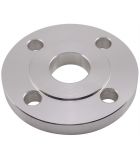
STAINLESS FLANGE
<h2>Stainless steel flanges. Buy online at the best price.</h2><p> Stainless flanges are a type of union flange that are manufactured using stainless steel, a material that is resistant to corrosion and oxidation. This type of flanges is used in a wide variety of applications, such as the construction of structures, equipment manufacturing, boilermaking, the chemical, metallurgical, and naval industries, among others.</p><p> Stainless flanges are characterized by being durable and resistant, making them suitable for corrosive or humid environments. In addition, they are also resistant to high temperature, making them suitable for applications where thermal resistance is required.</p><p> In terms of design, stainless flanges usually have a circular shape, have holes to be fastened with other flanges, using screws and nuts, and are available in different sizes and thicknesses to adapt to the needs of each application. They can also be available in different grades of stainless steel, which vary in terms of their resistance to corrosion and oxidation.</p><p> <strong>There are various types of grades in stainless flanges and they are used in different applications.</strong></p><p> -Type 304 Stainless Steel Flanges: This is one of the most common types of stainless flanges and is used in a wide variety of applications. It is resistant to corrosion and oxidation, but is not suitable for very corrosive environments.</p><p> -Type 316 Stainless Steel Flanges: This type of stainless flange is more corrosion resistant than type 304 and is suitable for marine and highly corrosive environments.</p><p> -Type 321 stainless steel flanges: This type of stainless steel flange is resistant to corrosion and high temperature, making it suitable for applications where thermal resistance is required.</p><p> -Type 347 stainless steel flanges: This type of stainless steel flange is resistant to corrosion and oxidation, and is also suitable for corrosive and humid environments.</p><p> -Welded flanges: This type of stainless flange is manufactured by welding, allowing for greater strength and greater structural integrity.</p><p> -Stainless steel flanges with insulating material: This type of stainless steel flange is used in applications where greater corrosion resistance and greater thermal insulation are required.</p><p> These are some of the most common types of stainless flanges. It is important to choose the right type of stainless flange for each application based on environmental conditions, strength needs, and specific technical requirements.</p><p> Regarding the classification of <strong>stainless steel flanges, we can summarize the following regulations:</strong></p><p> ASA/ANSI/ASME (USA), EN/DIN (Europe), BS10 (British/Australian) and JIS/KS (Japanese/Korean). Normally the flanges of different regulations are not interchangeable. And each regulation is divided depending on the different pressure ranges they can withstand.</p><p> The most common pressure classes are #150, #300, #600, #900, #1500, #2500 and #3000 according to ASME standards.</p><p> For other regulations, such as DIN, these pressure classes are defined by the acronym PN followed by the maximum pressure admissible through the flange in bars, such as, for example, PN10, PN16, PN20, PN25, PN40, PN50, PN100, PN150 , PN250 or PN420. As with flanges of different standards, flanges of different pressure classes are not usually interchangeable.</p><p> <strong>We can classify stainless steel flanges by their design into:</strong></p><p> Blind flanges: These are round plates without a center hole. They are used at the ends of pipes, valves or in pressure tanks. They are suitable for all standard tube sizes and high pressure ranges.</p><p> -Lock or Lap Flanges: This type of flanges can rotate around the pipe thus allowing easy alignment and coupling with bolts even after being welded. They are used in systems that require frequent disassembly.</p><p> -Sliding Flanges: Perfect for low pressure applications. They are designed to slide from the end of the pipe to the place where it will be welded. They imply simplicity and economic savings in installation.</p><p> -Flanges with welding seat: Used for small size and high pressure pipes. In these flanges the tube penetrates until it makes contact with the seat or plug and is welded to the flange.</p><p> -Threaded Flanges: They make up a special group of flanges since they can be assembled without the need for welding. They are used with small, low pressure tubes.</p><p> -Weld Neck Flanges: They are characterized by their long conical neck and are used in high pressure applications. The tapered center transfers stress to the tube and acts as a reinforcement, thus providing the force to counteract lateral tilt.</p><p> -Orifice Flanges: They are used as a replacement for standard flanges and allow the installation of a meter to measure the flow of liquids or gases.</p><p> -Reducing Flanges: They are used to change the size of the tube and are an economical means to change the size of the pipe. Neck, sliding and threaded flanges can be reducing. Another important parameter to define a flange is the faces.</p><p> <strong>There are mainly five types of flanges which we can see below:</strong></p><p> -Flat Face (FF): Flanges with a flat face have the gasket surface in the same plane as the circle where the screws are fixed. Applications that use flat face flanges are frequently those in which the joining flange or adjusting flange is made from a casting.</p><p> -Raised Face (RF): Flanges with raised faces are the most common type used in processing plants, and are easy to identify. If we refer to it as a raised face, it is because the contact surfaces have a raised surface around the central hole. This type of union allows the use of various types of joints.</p><p> -Ring gasket (RTJ): these pieces have slots on their faces into which steel ring gaskets are inserted. Flanges seal when bolts compress the ring between the flange grooves, deforming the gasket to achieve a metal-to-metal seal.</p><p> -Tongue and Grooved (T&G): The tongue and groove faces of these flanges must match. One face of the flange has a protruding ring (tongue) machined into the face of the flange while the mating flange has a mating depression (groove) machined into its face.</p><p> -Male and female (M&F): With this system the flanges must also match. One face of the flange has an area that protrudes from the flat face of the flange (male). The other flange or pair has a matching depression (female) machined into its face.</p> -
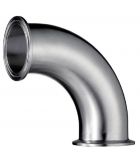
LINKS-CLAMP INOX FITTINGS
<h2>Fittings - Stainless Clamp Links. Buy online at the best price</h2><p></p><p> <strong>Clamp links or fittings</strong> , also known as grip links or clamping links, are devices used to secure the union between two pieces, such as flanges, tubes, hoses or conduits, among others. These links are designed to hold the piece securely and firmly, preventing accidental movement or displacement.</p><p> Clamp links consist of a stainless steel plate that fits around the piece to be clamped, and a fixing mechanism. These fixings join the two plates of the links together, using a joint with a specific type of shape.</p><p> Clamp links are basically made of quality 316 stainless steel and have various regulations.</p><p> The most important ones are:</p><ul style="list-style-type:disc;"><li> BS4825 for BWG/SWG tube (imperial) This standard sets out the specifications for clamp fittings used in sanitary piping systems, especially in the food and pharmaceutical industries.</li><li> ISO2852 for tube ISO 1127 this standard defines the dimensions, materials and characteristics of clamp fittings used in hygienic applications in the food, pharmaceutical and chemical industries.</li><li> DIN32676 for DIN 44850 tube this standard establishes the specifications for clamp fittings used in sanitary piping systems, especially in the food and pharmaceutical industries.</li></ul><p> There are several models of clamp fittings, designed to adapt to different types of pipes, hoses or conduits, and to meet the needs of specific applications. Some of the most common models are:</p><ul style="list-style-type:disc;"><li> Straight clamp fittings: this model is the most common and is used to join two straight sections of pipe or hose.</li><li> T-clamp fittings: this model is used to connect three sections of pipe or hose in a direction perpendicular to the center section.</li><li> Y clamp fittings: This model is used to connect three sections of pipe or hose in a Y-shaped direction.</li><li> Cross clamp fittings: this model is used to connect four sections of pipe or hose in a crossed direction.</li><li> Reducer clamp fittings: this model is used to connect pipe or hose sections of different diameters.</li><li> Elbow clamp fittings, at 45º or 90º: this model is also very common and is used to join two sections of pipe or hose.</li><li> Clamp fittings or also called TRICLAMP, for hose: this model is specifically used to join hoses and provide a hermetic seal.</li><li> Fittings with pink outlet, can be both male and female.</li></ul><p> We can also highlight several accessories and valves with clamp-type terminations that facilitate and extend a good installation with pipes and hoses. They can be butterfly or ball valves, non-return valves, valves with actuator, etc.</p><p> Clamp fittings or links are widely used in different industries, especially those that require a high degree of hygiene and safety in their piping systems.</p><p> Some of the industries where clamp fittings can be installed are:</p><ul style="list-style-type:disc;"><li> Food industry: in the production, processing and packaging of foods and beverages, including dairy products, beers, soft drinks, among others.</li><li> Pharmaceutical industry: in the production of medicines, biological products and chemicals used in human and animal health.</li><li> Chemical industry: in the production, processing and transportation of chemicals, petrochemicals, fuels and other fluids.</li><li> Cosmetic industry: in the production and packaging of cosmetic products, including creams, lotions, shampoos, among others.</li><li> Paper industry: in the production of paper and wood-derived products, such as cardboard and cellulose pulp.</li><li> Water treatment industry: in the production and distribution of drinking water and in the treatment of wastewater.</li><li> Semiconductor processing industry: in the production of chips and other electronic components.</li></ul> -
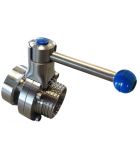
DIN-11851 STAINLESS STEEL LINKS
<h2>Links - DIN 11851 fittings. Buy online at the best price</h2><p> DIN 11851 links are a type of fitting used in the food, chemical, cosmetic and pharmaceutical industries to connect pipes, hoses and equipment. These fittings comply with the DIN 11851 standard, which establishes their dimensions and technical characteristics. They are manufactured solely and exclusively in stainless steel, having variations in the quality of stainless steel, AISI304 or AISI316.</p><p> DIN 11851 fittings consist of a male part and a rotating female part, which are joined by a gasket. Optionally, the male part has a safety ring that prevents the fitting from accidentally coming out of the pipe or equipment. The female part has notches, in which a tool is used to tighten and loosen the fitting. The union gasket can be made of various types of materials, depending on the fluid that will circulate, EPDM, NBR, SILICONE, PTFE, VITON etc...</p><p> DIN 11851 fittings are easy to clean and sterilize, making them suitable for use in sanitary and food and beverage processing applications. Additionally, they are designed to be compatible with other types of fittings, allowing greater flexibility in connecting equipment and pipes.</p><p> The <strong>most common applications of DIN 11851 fittings</strong> are:</p><ul style="list-style-type:disc;"><li> Food and beverage processing: DIN 11851 fittings are ideal for connecting pipes and equipment in food and beverage processing as they can withstand high temperatures and are corrosion resistant.</li><li> production of pharmaceutical products: DIN 11851 fittings are widely used in the production of pharmaceutical products due to their hygienic characteristics and sterilization capacity.</li><li> Cosmetic industry: DIN 11851 fittings are used in the cosmetic industry to connect pipes and equipment in the production of creams, lotions and other personal care products.</li><li> Dairy Industry: DIN 11851 fittings are commonly used in the dairy industry to connect equipment and pipes in the production of dairy products such as milk, cheese and yogurt.</li><li> Chemical Processing: DIN 11851 fittings are also used in the chemical industry to connect pipes and equipment in chemical production and transportation processes. The types of DIN 11851 links are varied to be able to connect in different ways. We can supply straight links, elbow links, tees, both male and female threads or combined. We can also supply DIN 11851 links for boring.</li></ul><p> We have the option of connecting shut-off or check valves, also with male or female threads or to be welded to the pipe.</p> -
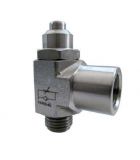
STAINLESS STEEL AUXILIARY VALVES
<h2>Stainless auxiliary valves. Buy online at the best price</h2><p> Stainless steel auxiliary valves are very common in the industry due to their high corrosion resistance, durability and ease of cleaning. Some most common valves for the industry are:</p><p> Ball valves Stainless steel ball valves are a type of valve that is used in all types of industries to control the flow of liquids or gases in a system. They are composed of a perforated ball and a valve body that can be manufactured in stainless steel, which makes them corrosion resistant and durable. Stainless ball valves are used in a wide variety of applications in the chemical, pharmaceutical, food and other applications requiring a high level of hygiene. Due to their simple and robust design, stainless ball valves are easy to install, operate and maintain, and are capable of withstanding high pressures and temperatures.</p><p> One of the main advantages of stainless ball valves is that they allow very precise fluid flow and quick, safe closure, which prevents leaks and minimizes the risk of contamination in the system. Additionally, the smooth surface of the stainless steel used in the manufacture of these valves makes them easy to clean and sterilize, which is essential in many applications where a high level of hygiene is required.</p><p> Stainless check valve or non-return valve is a type of valve used to allow fluid flow in one direction and prevent flow in the opposite direction. Check valves are important to prevent the flow of unwanted fluids, such as backwater in a water pipe or the reverse flow of chemicals in a process line. Stainless steel is a popular material for check valves due to its corrosion resistance and ability to withstand high temperatures and pressures. Stainless steel check valves are commonly used in industrial applications, such as in the food, chemical and pharmaceutical industries, as well as applications in the oil and gas industry.</p><p> Stainless steel filters are commonly used in applications where high resistance to corrosion and oxidation, as well as high mechanical strength, is required. Stainless steel filters are used in a wide variety of applications, such as filtration of liquids and gases in industrial processes, filtration of drinking water, filtration of chemicals, and in the food and pharmaceutical industries. The durability of stainless steel also makes it suitable for use in high-pressure, high-temperature filtration applications.</p><p> Stainless steel filters can come in different shapes and sizes, such as conical, cylindrical, fine or coarse mesh, and can be customized to fit specific needs. Choosing the right stainless steel filter will depend on the specific application and filtration requirements.</p><p> Stainless safety valves are devices used in piping systems and industrial processing equipment to protect against excess pressure. These valves are designed to automatically release excess pressure in the system and prevent equipment failure or system damage. Stainless safety valves are made of ANSI 304 or ANSI 316 quality stainless steel, making them resistant to corrosion and wear. This is particularly important in applications involving corrosive fluids or in humid, saline environments. Stainless safety valves are available in different sizes and configurations, and are used in a wide range of applications, such as the food, pharmaceutical, chemical and petrochemical industries, among others.</p><p> It is important to select the appropriate safety valve for the specific application and ensure that it meets applicable safety regulations and standards. A stainless quick release is a component used in piping systems and industrial processing equipment that allows for the quick and safe disconnection of a section of piping or equipment, usually pneumatic cylinders.</p><p> These quick escapes are also known as quick couplers or quick disconnects. Stainless quick exhausts are made of high quality materials, making them resistant to corrosion and wear. These quick exhausts are commonly used in applications involving corrosive fluids, high pressure and high temperature. We can select the internal gasket in various materials, PTFE, VITON, EPDM, VQM etc.</p><p> Stainless quick exhausts are available in different sizes and configurations to suit specific application needs. Additionally, these components are designed for quick and easy disconnection, minimizing downtime and improving operating efficiency.</p><p> A stainless flow regulator is a device used in piping systems and industrial processing equipment, such as pneumatic cylinders, to control and adjust the flow of a fluid through the pipeline. These flow regulators are also known as flow control valves. They are resistant to corrosion and wear.</p><p> These flow regulators are commonly used in applications involving corrosive fluids, high pressure and high temperature. Stainless flow regulators are available in different sizes and configurations to suit specific application needs. Additionally, these devices are designed for precise and constant flow control, which improves operating efficiency.</p> -
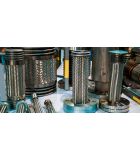
STAINLESS STEEL HOSE
<h4 style="text-align:center;">Stainless Steel Hoses. Buy them online at the best price.</h4><h4 style="text-align:center;"> Also custom manufacturing</h4>
The sanitary stainless steel range is made up of different accessories, forged links, tube accessories and others such as valves, sight glasses, etc.
The accessories are manufactured under the DIN 11851 / 11852 standard, known for hygienic connections in the food industry. Others such as SMS 1146 can be supplied upon request. The clamp connections follow the BS 4825 and DIN 32676 standards.
The food gasket is an important component, the tightness of the connection depends on it. They can be supplied in different materials: Silicone (MVQ), EPDM, NBR, FPM and PTFE. The gaskets available in stock meet the FDA criteria and parameters; when the project requires it, the FDA certificate can be requested at the time of order.
The tubes are manufactured according to standard EN 10357 (DIN 11850) Series A (formerly Series 2) and Series B (formerly Series 1) and standard EN 10357 (ISO 2037) Series D and must have an internal laminated welding bead, which must be checked. welding using the EDDY CURRENT test according to ASTM-A450 standard.
The surface finish can be satin, bright polished or simply pickled.
Material: 1.4404 (AISI-316L) / 1.4301 (AISI-304). Measurements from NW10 to NW200

